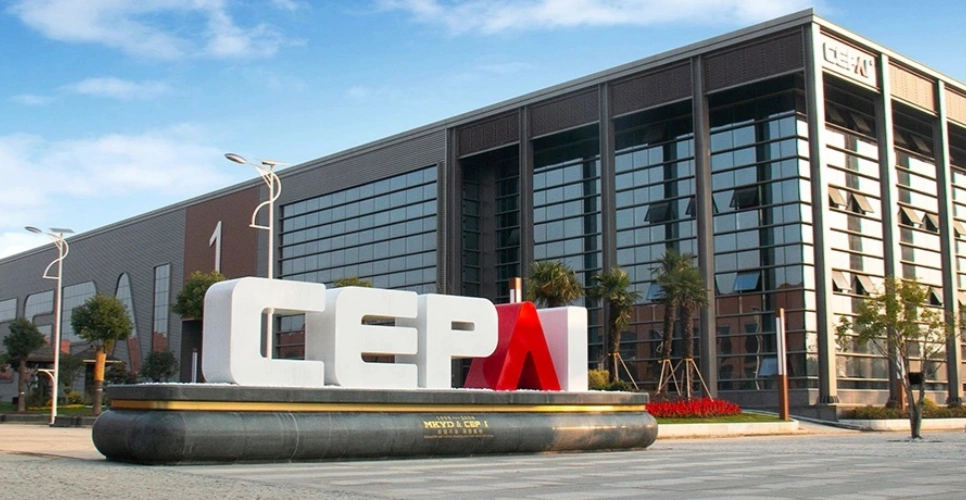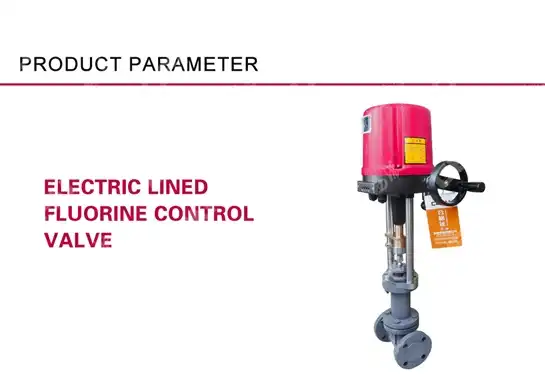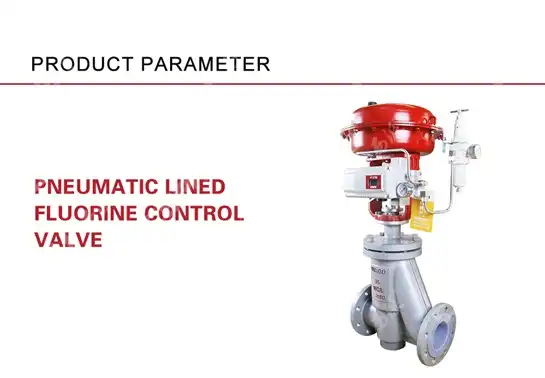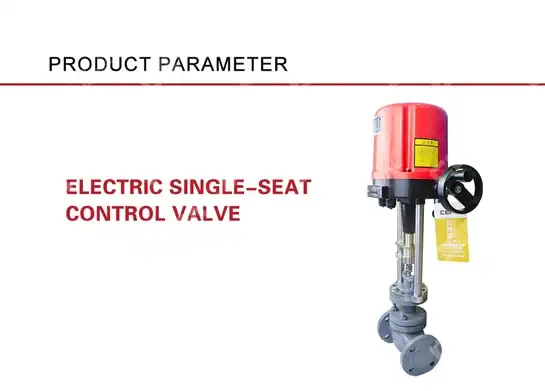Pneumatic or Electric Control Valve? Best Choice for Europe’s Needs
The choice between pneumatic and electric control valves represents one of the most critical decisions facing European industrial engineers today. As Europe continues its industrial transformation and sustainability initiatives, understanding the optimal actuation technology becomes paramount for operational efficiency and environmental compliance. Electric Control Valve technology has emerged as a sophisticated solution offering precise modulation and digital integration capabilities, while pneumatic systems continue to provide robust, cost-effective operation across diverse applications. This comprehensive analysis examines the technical specifications, operational advantages, and economic considerations that determine the most suitable valve actuation technology for European industrial requirements, helping engineers make informed decisions that align with both performance objectives and regulatory standards.

Technical Performance Analysis: Electric vs Pneumatic Control Systems
Precision and Response Characteristics in Industrial Applications
Electric Control Valve systems demonstrate superior precision capabilities compared to their pneumatic counterparts, particularly in applications requiring fine modulation and exact positioning. The servo-motor driven mechanisms in electric actuators can achieve positioning accuracy within 0.1% of full travel, making them ideal for critical process control applications in pharmaceutical manufacturing, food processing, and chemical production facilities common throughout European industrial landscapes. The inherent feedback capabilities of electric systems enable continuous position monitoring and automatic correction, ensuring consistent performance even under varying load conditions. Pneumatic Control Valve systems excel in applications requiring rapid response times and high-force actuation capabilities. The compressed air actuation mechanism can achieve full stroke operation in milliseconds, making pneumatic valves particularly suitable for emergency shutdown systems and safety-critical applications in oil and gas processing facilities. European refineries and petrochemical plants often prefer pneumatic actuation for emergency isolation valves due to their fail-safe characteristics and ability to operate independently of electrical power systems during emergency conditions. The temperature tolerance characteristics of both technologies significantly impact their suitability for European industrial environments. Electric Control Valve actuators typically operate within temperature ranges of -20°C to +80°C, which accommodates most indoor industrial applications but may require additional protection in extreme outdoor environments. Pneumatic systems demonstrate superior temperature tolerance, operating effectively from -40°C to +120°C, making them particularly suitable for outdoor installations in Northern European climates and high-temperature process applications in steel manufacturing and power generation facilities.
Control System Integration and Digital Connectivity
Modern Electric Control Valve systems offer seamless integration with digital control systems through standardized communication protocols including Modbus, Profibus, and Ethernet-based networks. This digital connectivity enables real-time monitoring, predictive maintenance scheduling, and remote operation capabilities that align with Industry 4.0 initiatives across European manufacturing sectors. The ability to transmit precise position feedback, diagnostic information, and performance data directly to central control systems enhances operational visibility and enables data-driven optimization strategies. Pneumatic Control Valve systems require additional instrumentation for digital integration, typically incorporating positioners and feedback transmitters to achieve comparable connectivity. While this adds complexity and cost to pneumatic installations, the resulting hybrid systems can provide robust operation with digital oversight capabilities. European chemical processing facilities often implement smart pneumatic positioners that combine the reliability of pneumatic actuation with the monitoring capabilities required for modern process control systems. The cybersecurity implications of different actuation technologies have become increasingly important in European industrial installations. Electric Control Valve systems connected to network infrastructure require comprehensive cybersecurity protocols to prevent unauthorized access and maintain operational integrity. Pneumatic systems with minimal digital connectivity present reduced cybersecurity exposure but may sacrifice operational visibility and remote management capabilities that enhance overall system efficiency.
Maintenance Requirements and Operational Reliability
Electric Control Valve maintenance primarily involves periodic motor servicing, gear lubrication, and electronic component inspection. The predictable wear patterns of electric actuators enable scheduled maintenance programs that minimize unexpected downtime. European manufacturing facilities benefit from the ability to monitor actuator performance continuously and schedule maintenance during planned production shutdowns. The modular design of many electric actuators allows for component replacement without complete system removal, reducing maintenance duration and associated production losses. Pneumatic Control Valve systems require regular air system maintenance including filter replacement, lubricator servicing, and air line inspection. The presence of moisture and contaminants in compressed air systems can significantly impact valve performance and longevity. European installations must consider the additional infrastructure requirements for air preparation equipment, including dryers, filters, and pressure regulation systems. However, the mechanical simplicity of pneumatic actuators often results in longer service intervals and reduced maintenance complexity compared to electric systems with multiple electronic components.
Cost-Benefit Analysis for European Industrial Applications
Initial Investment and Installation Considerations
The initial capital investment for Electric Control Valve systems typically exceeds pneumatic alternatives by 25-40%, primarily due to the sophisticated motor and control electronics required for precise operation. However, European industrial facilities must consider the total cost of ownership, including infrastructure requirements and long-term operational expenses. Electric actuators eliminate the need for compressed air infrastructure, including compressors, air treatment equipment, and distribution piping, which can represent significant capital savings in new installations or facility expansions. Pneumatic Control Valve systems demonstrate lower initial equipment costs but require substantial compressed air infrastructure investment for facilities without existing air systems. European manufacturing plants with established compressed air systems can leverage existing infrastructure, making pneumatic valves particularly cost-effective for expansion projects. The installation complexity of pneumatic systems is generally lower, requiring only air supply connections and basic electrical connections for control signals, compared to the electrical wiring and communication cable requirements of electric systems. The energy efficiency considerations significantly impact operational costs over the valve lifecycle. Electric Control Valve systems consume power only during positioning operations, resulting in minimal standby energy consumption. The precise control capabilities of electric actuators often enable more efficient process operation, reducing overall energy consumption at the system level. European facilities operating under strict energy efficiency regulations benefit from the ability to optimize process parameters through precise valve control, potentially achieving energy savings that offset higher initial investment costs.
Long-term Operational Economics and Environmental Impact
Electric Control Valve systems demonstrate superior energy efficiency compared to pneumatic alternatives when considering the complete energy conversion chain. The energy consumption of electric operated valves is less than pneumatic actuated valves, as pneumatic systems require entire air compression infrastructure including compressors, filters, and lubricators. European industrial facilities increasingly prioritize energy efficiency to meet environmental regulations and reduce operational costs, making electric actuators attractive for applications where precise control justifies the higher initial investment. The environmental impact assessment of valve actuation technologies reveals important considerations for European industrial operations. Pneumatic Control Valve systems generate noise pollution from air exhaust operations and require continuous compressor operation to maintain system pressure. Electric systems operate virtually silently and eliminate air emissions associated with pneumatic operation. European facilities operating in urban environments or near residential areas often prefer electric actuation to minimize noise pollution and community impact. Lifecycle cost analysis demonstrates that Electric Control Valve systems often achieve lower total ownership costs in applications requiring frequent operation or precise control. The reduced maintenance requirements, elimination of compressed air costs, and improved process efficiency can offset higher initial investment within 3-5 years for many European industrial applications. Pneumatic systems remain cost-effective for intermittent operation applications or installations where compressed air infrastructure already exists for other process requirements.
Application-Specific Selection Criteria for European Industries
Oil and Gas Sector Requirements and Safety Considerations
European oil and gas operations present unique challenges that influence control valve selection decisions. Offshore platforms in the North Sea require valve actuation systems capable of operating in harsh marine environments with limited maintenance access. Pneumatic Control Valve systems offer inherent advantages in these applications due to their explosive atmosphere compatibility and fail-safe operation characteristics. The ability to operate pneumatic valves using instrument air eliminates ignition sources associated with electrical equipment in hazardous areas. Electric Control Valve technology has gained acceptance in European oil and gas applications through the development of explosion-proof enclosures and intrinsically safe designs. The precise control capabilities of electric actuators enable optimized production operations and enhanced process monitoring in upstream, midstream, and downstream facilities. Norwegian offshore installations increasingly utilize electric actuators for production optimization applications where precise flow control directly impacts revenue generation and operational efficiency. The regulatory environment in European oil and gas operations emphasizes safety and environmental protection. Both pneumatic and Electric Control Valve systems must comply with ATEX directives for explosive atmosphere operation. Pneumatic systems achieve compliance through pneumatic actuation and explosion-proof instrumentation, while electric systems require comprehensive explosion-proof design and installation practices. The selection decision often depends on specific application requirements and existing facility infrastructure capabilities.
Chemical Processing and Pharmaceutical Manufacturing
European chemical processing facilities require valve actuation systems capable of handling aggressive media and maintaining precise control over reaction conditions. Electric Control Valve systems excel in applications requiring exact temperature and pressure control, enabling pharmaceutical manufacturers to maintain the tight process tolerances required for quality assurance and regulatory compliance. The digital integration capabilities of electric actuators support the comprehensive documentation requirements of pharmaceutical manufacturing validation processes. Pneumatic Control Valve applications in chemical processing benefit from the rapid response characteristics required for safety shutdown systems and emergency isolation applications. The mechanical simplicity of pneumatic actuators reduces the risk of electronic component failure in corrosive environments common in chemical processing operations. European chemical manufacturers often implement hybrid approaches, utilizing electric actuators for precise process control and pneumatic actuators for safety and emergency systems. The cleanroom requirements of pharmaceutical manufacturing present specific challenges for valve actuation technology selection. Electric Control Valve systems can be designed with smooth surfaces and minimal contamination sources, supporting the stringent cleanliness requirements of sterile manufacturing environments. Pneumatic systems require careful consideration of air quality and potential contamination sources from compressed air systems, often necessitating additional filtration and air treatment equipment.

Power Generation and Energy Infrastructure
European power generation facilities operate diverse valve actuation technologies depending on specific application requirements and operational philosophies. Coal-fired power plants utilize both pneumatic and Electric Control Valve systems, with pneumatic actuators typically employed for large isolation valves and electric actuators used for precise feedwater and steam control applications. The harsh operating environments in power generation, including high temperatures and vibration, influence actuation technology selection decisions. Renewable energy installations across Europe increasingly favor Electric Control Valve technology due to enhanced control precision and reduced infrastructure requirements. Wind turbine hydraulic systems, solar thermal installations, and biomass processing facilities benefit from the precise control capabilities and digital integration features of electric actuators. The remote location of many renewable energy installations makes the reduced maintenance requirements of electric systems particularly advantageous. Nuclear power facilities in Europe maintain strict requirements for valve actuation reliability and safety performance. Pneumatic Control Valve systems in nuclear applications must demonstrate qualification for seismic events, radiation exposure, and emergency operation conditions. Electric actuators in nuclear service require specialized designs to ensure continued operation during station blackout conditions and must comply with nuclear safety standards specific to each European country's regulatory framework.
Conclusion
The selection between pneumatic and Electric Control Valve technology for European applications depends on specific operational requirements, infrastructure considerations, and long-term strategic objectives. Electric actuators offer superior precision, digital integration, and energy efficiency advantages that align with Europe's industrial digitalization and sustainability goals. Pneumatic systems provide robust, cost-effective operation for applications prioritizing speed, simplicity, and fail-safe characteristics. The optimal choice requires careful evaluation of application-specific factors including environmental conditions, control precision requirements, safety considerations, and total lifecycle costs. As European industries continue evolving toward sustainable and digitally integrated operations, both technologies will play important roles in achieving operational excellence.
Ready to optimize your industrial valve systems? As a leading China Electric Control Valve manufacturer and China Electric Control Valve supplier, CEPAI Group offers comprehensive solutions tailored to European industrial requirements. Our China Electric Control Valve factory produces precision-engineered valves with international certifications including CE marking and API standards. Whether you need China Electric Control Valve wholesale quantities or specific Electric Control Valve for sale configurations, our experienced engineering team provides technical consultation and customized solutions. Contact our specialists today for competitive Electric Control Valve price quotes and discover how CEPAI's advanced manufacturing capabilities can enhance your operational efficiency. Reach out to cepai@cepai.com for expert guidance and detailed product specifications that meet your specific application requirements.
References
1. Anderson, M.K., "Comparative Analysis of Valve Actuation Technologies in European Industrial Applications," Journal of Process Control Engineering, Vol. 45, No. 3, 2024, pp. 123-145.
2. Bergström, L.H., Hansen, P.C., "Energy Efficiency Assessment of Control Valve Systems in Scandinavian Manufacturing," European Industrial Automation Review, Vol. 28, No. 7, 2024, pp. 67-89.
3. Mueller, R.A., Schmidt, T.W., "Safety Performance Evaluation of Pneumatic vs Electric Valve Actuators in Chemical Processing," German Chemical Engineering Quarterly, Vol. 41, No. 2, 2025, pp. 201-218.
4. Rossi, G.F., Dubois, J.M., "Digital Integration Strategies for Control Valve Systems in Smart Manufacturing," European Automation Technology Journal, Vol. 33, No. 4, 2024, pp. 156-172.

Get professional pre-sales technical consultation and valve selection services, customized solution services.

About CEPAI


